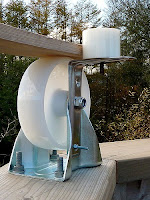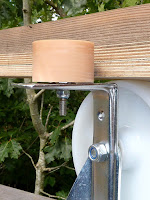*
Wednesday: The bolts dispatch is finally notified just as we have a 15 minute,
torrential cloudburst.
The following is a wordy example of my thought process in arriving at my original lift stop disks. Feel free to skip over it:
Thursday: The M6 x 90mm hex csk head bolts arrived late morning. I then started
drilling down through the original wood screw holes with a 6mm bit. By
working from the outside of the octagon I could reach the drilled holes in the
base ring from the underside with a countersink in the rechargeable
drill. The bolts were then pushed upwards from below, an oversized washer slipped over and finally a nut. The 12mm Ø CSK heads were then pulled below the surface of the dome rotation track. Cranking on a
small ratchet driver with a 10mm socket then pulled the horizontal struts and base
ring tightly together.
The forecast, for this evening and tomorrow, is for extended and heavy, thundery
rain and high winds. The open dome skeleton is presently in little danger from the wind
but is bound to get rather wet. Gluing and sealing of the gores and covering panels will now have to be timed depending on the weather.

This total change in
previously stable, hot and dry, weather conditions is requiring a rapid rethink of safety factors should the dome covering panels go on. The dome then becomes subject to wind loads
and possibly lift. Particularly before the shutters close off the still wide-open observation slit of the dome. Perhaps I should have the shutters ready first?
I had better start fitting lift restraints
on top the steering wheel bolts. These plates need be no more than rectangles of thick [10mm?] aluminium with a hole in each for the steering wheels, axle bolts. The plates will skim just
above the base ring as the dome is rotated. So that each becomes a solid lift
stop in the unlikely event of any aerodynamic lift during gales or
stormy gusts.
An alternative would be cut circles of aluminium to fit on top of the steering wheels and [perhaps] rotate with them. A small spacer will ensure the upper wheel bearings are lightly pre-loaded. Since I have eight to make it might be worth using a large hole saw and finishing off the disks in the lathe. I'll have to check the required diameter. I don't have any alu. round bar stock of sufficient size. Besides parting off disks of the likely diameter in the lathe takes far too long.
I don't remember any commercial disks, or suitable wheels, which would suit as donor material. These disks need to be smooth as they will literally protrude into the observatory. Anything sharp edged might cause serious injury in the dark as they are exactly at head height. Which is why I am seriously considering disks rather than rectangles or squares. They need to be thin, stiff, long lasting and strong. I can easily 'soften' the sharp edges of metal disks in the lathe.

The dome retention plates obviously need to be larger than
the steering wheels so that they overlap the base ring. About 90-100mm Ø would do. The ribs would have to be notched at their base to let the disks pass through them. The plywood base ring is not perfectly round and the dome 'wanders' slightly during rotation. So there is no point in trying to use undersized disks.
I shall have to modify the skateboard wheels by cutting away the downward facing 'cupped' side to lower their top surface. This will allow me to remove the present packing nuts. Which had to be inserted in the depth of the wheel "cup" to clear the shelf brackets. Removing 7mm of wheel height was enough.
Best achieved by holding a hacksaw
very firmly in contact with the spinning wheel in the lathe. Followed by a clean up cut. I tried water and soapy water as cutting fluids but they didn't help. The experts freeze their wheels before attacking them with a lathe.

Other dome
builders have fitted parking lift restraints or hooks. Which are set [and
sometimes tensioned] only when the dome is not actively in use. I may add these
types of restraints later as extra insurance for storms. Though I hope the multiple plates or disks [all 8 of them] will be adequate by
themselves for more normal, but windy weather.
Friday: I went up to the observatory as the tail end of a storm still buffeted the woodwork. Inserting my finger into a deliberate gap between the pyramidal pier and the observatory floor suggested only microscopic relative movement. The mounting pier is, of course, fully isolated from the observatory structure. This is to ensure footfalls [and the wind] don't cause vibration in the highly magnified, telescope image. The pier is sheltered from the wind by the building.
Narrowing the skateboard steering wheels was completed one at a time. Then each one replaced on the dome support ring. Removal of them all at once was considered too risky in the very windy conditions. Online searches [on eBay] for pre-cut disks in aluminium or stainless steel showed they are ridiculously uneconomical. I shall have to make my own disks from scrap, sheet aluminium. It is just a matter of how best to do it in the minimum of time.

Cutting squares [or rectangles] is easy enough on the miter saw. Drilling and bolting each in turn will provide a means of support in the lathe. It would be better if the corners could be removed first to ease the impact loads when turning them round. The miter saw is not the ideal tool for trimming of small items. Perhaps the jig saw is the answer? Unfortunately, the 8mm bolt diameter is really not ideal for stacking several disks at a time. The disks cannot rotate with the wheels anyway.
Perhaps I should rethink the disks idea and return to squares. Or completely separate the steering wheels from the means of vertical dome retention? I looked at this option and realised it would be visually clumsy.
Squares with well rounded corners, for safety, will do. They would be stronger than disks and less able to become unhooked by simultaneous lateral and vertical loads. Rectangles it is then. I chopped them out from 15cm wide scrap 10mm thick aluminium on the miter saw and then quickly smoothed the edges and corners with the 12" disk sander. I used lamp oil as a cutting medium on the saw but still had blocked teeth on each cut. The problem now is deciding on the best amount of base ring overhang.
Later, I realised that square lift stops would rotate if the corners dug into the dome structure. Which would lock the dome against further rotation. The radius to the corners is far greater than the radius to the sides. So it's back to disks and I have one finished and more ready to turn in the lathe. The miter saw can cope with the small squares by clamping them down onto the bed with Bessey F-clamp and lowering the saw very slowly. This allowed me to take all the corners off. Which saved a lot of time.
Click on any image for an enlargement.
*
